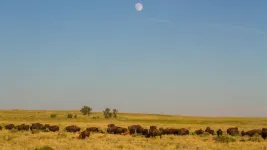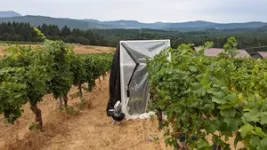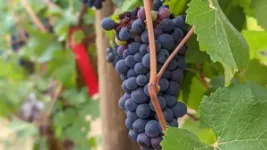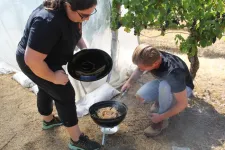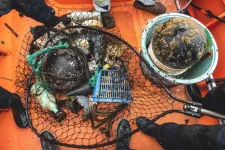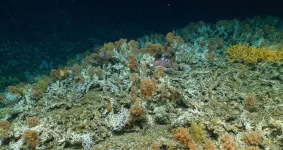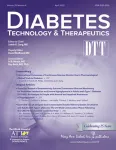(Press-News.org) It epitomizes the Great Plains in spirit and in form: a 2,000-pound tank on hooves, cloaked in shaggy winter-tested coat, capped by horns acting as warning and weapon.
Even its scientific name, Bison bison bison, seems to conjure an echo worthy of its majesty. Still, the implacable profile of the Plains bison — the national mammal of the United States and largest on the continent — belies the vulnerability in its history, which saw its legions decimated from tens of millions to just a few hundred in the span of a few colonial centuries.
Conservation efforts have pushed its number back to roughly 20,000, and its status from endangered to near-threatened. But a recent study led by the University of Nebraska–Lincoln’s Nic McMillan hints that the ongoing conservation of the Plains bison will demand accounting for the climate — especially the number of scorching days and powdery landscapes — it encounters moving forward.
McMillan and colleagues at Oklahoma State University have found GPS-backed evidence that temperature and extreme drought can drive movement among herds of Plains bison. Continued increases in both, combined with the fact that most bison herds are now confined to fractions of the land they once roamed, could pose challenges to managing the iconic species, McMillan said.
“When we think about reintroducing bison or any large animal to a landscape, the landscape that the animal is inhabiting is potentially a lot smaller than it was historically,” said McMillan, assistant professor of agronomy and horticulture at Nebraska. “In 1491, if there was a drought in northeastern Montana, the bison had the entire Great Plains to escape that drought. They could move as far as they needed to.
“In this time when we’re seeing more extremes — more of those extreme air temperatures, more of those extreme droughts — we probably need to rethink how these landscapes are structured, and whether or not they’re actually meeting the fundamental physiological needs of these animals.”
The team reached its conclusions after analyzing the movement data of 33 Plains bison from two disparate sites in Oklahoma: the Wichita Mountains Wildlife Refuge in the southwestern part of the state, and the Tallgrass Prairie Preserve near its northern border. Each of the bison wore GPS-equipped collars that tracked their location every 12 minutes over multiple years, yielding a total of 715,344 measurements. Pairing that data with temperature, rainfall, wind and other variables recorded by nearby weather stations, plus drought-revealing moisture readings of the soils at both sites, allowed the team to search for links between bison movement and weather.
Air temperature explained variations in bison movement better than any other factor the researchers analyzed. When the temperature ranged from a few degrees below zero to 83 degrees Fahrenheit, bison movement increased 92.5% for every 18-degree rise, so that movement nearly doubled when the temperature rose from, say, 65 degrees to 83 degrees. Above that threshold — from 83 degrees through at least 112, the highest recorded temperature — an 18-degree increase instead corresponded to a 48.5% decrease in movement.
The temperature-related increase in movement hints that the Plains bison were in search of grasses that grew better amid the greater heat, the team said, especially given that bison get the majority of their water from foraging. The reduced movement in the face of excessive heat, meanwhile, suggests that they rested and cooled themselves in places where standing water and the shade of nearby trees prevented the equivalent of heat stroke.
“When you consider (that) this is the first study of Plains bison across multiple herds — and then we find the same relationship across herds, in two very different landscapes — that’s a big deal,” said McMillan, who noted that the trend also paralleled a study of wood bison in Canada.
In looking for potential effects of drought, the team turned to sensors that measured soil moisture at two depths: 5 centimeters, where dryness indicates moderate drought, and 25 centimeters, where it signifies severe drought. Though bison seemed mostly unaffected by the former case, reinforcing that they can tolerate moderate drought by taking up water through vegetation, they moved substantially more when contending with the severe drought that struck Oklahoma in the early 2010s.
“There’s a lot of (prior) research that suggests that bison are basically drought-proof,” said McMillan, who also holds an appointment with the School of Natural Resources. “They’re like these tanks out on the prairie that don’t need anything. They can just take whatever comes, and no big deal. At least, that’s the dogma in the reintroduction world.
“So I think this is really interesting, because we show that, hey, they still are not immune to drought. They have this potential threshold where they can’t handle it.”
‘I was just hooked’
Back when bison blanketed the Great Plains, they served not just as a vital food source and cultural touchstone for Indigenous peoples but also a species that many others, animal and plant, relied on for survival, McMillan said. Following the dwindling of their population and eventual relocation to protected areas, Plains bison may or may not serve the same ecological purposes they once did. Regardless, McMillan said their place in the history of the continent and country should be preserved in the animals themselves.
“They’re incredibly culturally important and represent the cultural identity for all of the Plains tribes, at a minimum,” McMillan said. “But they also represent one of the most charismatic animals that we have in North America. So they’re really important for our identity as a country and all the people who live here.”
They resonate with McMillan on another frequency, too. As the son of a plant biologist and ecologist who hosted a national TV show that aired on PBS, the South Carolina native tagged along with his father on a visit to Nebraska when he was 15. That visit, and the vistas he took in from atop the badlands of western Nebraska, would kindle his “profound attachment” to bison and help set the course of his career.
“We came to the Great Plains, and I was just hooked,” he said. “I never thought about anything else after that. I never necessarily originally envisioned myself being a scientist or studying bison as a scientist, but I was just always fascinated by how they exist on the landscape, bringing them back — that really emotional story. So for me, it’s very personal.”
McMillan said he hopes the team’s findings can inform the management of Plains bison in places like Yellowstone National Park, which houses the largest wild herd of the species. Those findings, he said, make the case for paying attention to what the animal’s behavior is telling ecologists and conservationists. Though the size and natural beauty of national parks and other protected areas may seem to offer everything the Plains bison could need, the fact that the animals still attempt to leave would seem to suggest otherwise.
And if the heat and extreme drought that apparently encourage Plains bison to move are only becoming more commonplace, then the space that was once considered sufficient may no longer be, McMillan said. That issue could be compounded by the fact that ensuring the diversity of their habitat — that they have access to grasslands, but also trees, and also standing water — appears to become even more important as that habitat shrinks.
“Then it’s an ethical question for us,” McMillan said. “Are we really being ethical if we’re forcing these animals to live in a landscape that may not actually be suited for them into the future? Whether bison were in Yellowstone historically is irrelevant to the likelihood that they can persist there into the future. Because today is completely and fundamentally different than yesterday.”
END
Temperature, drought influencing movement of Plains bison
Findings could guide management of Great Plains icon
2023-04-17
ELSE PRESS RELEASES FROM THIS DATE:
Oregon State researchers make breakthrough in understanding the chemistry of wildfire smoke in wine
2023-04-17
CORVALLIS, Ore. – Oregon State University researchers have discovered a new class of compounds that contributes to the ashy or smokey flavors in wine made with grapes exposed to wildfire smoke.
This development is significant for winemakers who have struggled to combat the impact of smoke on grapes at a time when climate change is leading to an increase in the number and severity of wildfires, the researchers said.
“These findings provide new avenues for research to understand and prevent smoke taint in grapes,” said Elizabeth Tomasino, an associate professor of enology ...
Coastal species persist on high seas on floating plastic debris
2023-04-17
The high seas have been colonized by a surprising number of coastal marine invertebrate species, which can now survive and reproduce in the open ocean, contributing strongly to the floating community composition. This finding was published today in Nature Ecology and Evolution by a team of researchers led by the Smithsonian Environmental Research Center (SERC) and the University of Hawai‘i (UH) at Mānoa.
The researchers found coastal species, representing diverse taxonomic groups and life history traits, in the eastern North Pacific Subtropical Gyre on over 70 percent of the plastic debris ...
UCF researchers create digital map of sympathetic nervous system
2023-04-17
UCF Researchers Create Digital Map of Sympathetic Nervous System
A team of UCF College of Medicine researchers has created a digital topographical map of the cardiac sympathetic neural network, the region that controls the body’s heart rate and its “fight-or-flight” response. They hope this map will eventually serve as a guide to treat cardiovascular conditions using bioelectronic devices.
The study, led by Dr. Zixi Jack Cheng, a neuro-cardiovascular scientist, was published in the Scientific Reports journal ...
UCF scientist publishes book on emergence of new pathogens
2023-04-17
Climate change may be linked to an increase in the emergence of new pandemics, according to a new book published by an internationally recognized College of Medicine microbiologist.
Dr. Salvador Almagro-Moreno has teamed with fellow molecular biologist Dr. Stefan Pukatzki of City University New York – CUNY, to author the book titled Vibro spp. Infections, recently published by Springer Nature and includes the latest scientific research articles in this field from experts worldwide.
The book examines the factors associated with ...
Prime editing shows proof of concept for treating sickle cell disease
2023-04-17
(MEMPHIS, Tenn. – April 17, 2023) Sickle cell disease (SCD) is a serious blood disorder affecting millions of people, primarily those of African descent. A mutation in the gene that encodes a subunit of the oxygen-carrying molecule, hemoglobin, causes the disease. Scientists at St. Jude Children’s Research Hospital and the Broad Institute of MIT and Harvard showed a precise genome editing approach, prime editing, can change mutated hemoglobin genes back to their normal form in SCD patient cells, which restores ...
JNM publishes appropriate use criteria for lymphoscintigraphy in sentinel node mapping and lymphedema/lipedema
2023-04-17
Reston, VA—The Society of Nuclear Medicine and Molecular Imaging (SNMMI) and 10 other professional societies have issued new appropriate use criteria (AUC) for lymphoscintigraphy in sentinel node mapping and lymphedema/lipedema. The criteria, summarized in the April issue of The Journal of Nuclear Medicine (JNM), include a list of relevant clinical scenarios, a systematic review of evidence in the literature, and a systematic analysis of available evidence, followed by grading each of the clinical scenarios.
Sentinel lymph nodes ...
Father of the photonic bandgap to speak at Utah State University
2023-04-17
Renowned physicist, engineer and entrepreneur Eli Yablonovitch will visit Utah State University on April 25 for two lectures about his work in the electrical and computer engineering field.
Yablonovitch, who is currently a professor emeritus at the University of California Berkeley, will present lectures on controlling carbon intake as a solution to climate change and on physics and optimization in the engineering world. The lectures will take place on April 25, at 1 pm and 3 pm respectively. An RSVP form can be found on this webpage. All are encouraged to attend.
“Having Dr. Yablonovitch travel to speak to us is a great honor and a great opportunity for us ...
Scientists discover pristine deep-sea coral reefs in the Galápagos Marine Reserve
2023-04-17
17 April 2023 - Galápagos, Ecuador – Scientists have discovered extensive, ancient deep-sea coral reefs within the Galápagos Marine Reserve (GMR) – the first of their kind ever to be documented inside the marine protected area (MPA) since it was established in 1998. The first reef observed was found at 400-600m (1,310-1,970 feet) depth at the summit of a previously unmapped seamount in the central part of the archipelago and supports a breathtaking mix of deep marine life.
Cresting the ridge of a submerged volcano, and stretching over several kilometers, the impressive reef structure was first recorded by Dr. Michelle ...
New discovery stops bacterial virus contamination
2023-04-17
A new discovery by researchers at the University of Warwick could help stop bacteria being contaminated with viruses, reducing disruption and decreasing costs in industry and research.
Bacteria are routinely used in biological and biomedical research. They are crucial in food production and emerging industrial biotechnologies, where bacterial ‘factories’ can be used to produce new materials, medicines and chemicals. Industrial biotechnology uses microorganisms as alternatives to traditional ...
A meta-analysis of hybrid-closed loop control-IQ technology
2023-04-17
A new study evaluated the effect of hybrid-closed loop Control-IQ technology in the pooled data from three randomized controlled trials, comparing Control-IQ to a control group using continuous glucose monitoring in people with type 1 diabetes. The study, which examined subgroup based on baseline characteristics such as race/ethnicity, socio-economic status, pre-study insulin delivery modality, and baseline glycemic control, is published in the peer-reviewed journal Diabetes Technology & Therapeutics (DTT). Click here to read the article now.
Roy W. Beck, MD, PhD, from the JAEB ...
LAST 30 PRESS RELEASES:
A new way to map how cells choose their fate
Numbers in our sights affect how we perceive space
SIMJ announces global collaborative book project in commemoration of its 75th anniversary
Air pollution exposure and birth weight
Obstructive sleep apnea risk and mental health conditions among older adults
How talking slows eye movements behind the wheel
The Ceramic Society of Japan’s Oxoate Ceramics Research Association launches new international book project
Heart-brain connection: international study reveals the role of the vagus nerve in keeping the heart young
Researchers identify Rb1 as a predictive biomarker for a new therapeutic strategy in some breast cancers
Survey reveals ethical gaps slowing AI adoption in pediatric surgery
Stimulant ADHD medications work differently than thought
AI overestimates how smart people are, according to HSE economists
HSE researchers create genome-wide map of quadruplexes
Scientists boost cell "powerhouses" to burn more calories
Automatic label checking: The missing step in making reliable medical AI
Low daily alcohol intake linked to 50% heightened mouth cancer risk in India
American Meteorological Society announces Rick Spinrad as 2026 President-Elect
Biomass-based carbon capture spotlighted in newly released global climate webinar recording
Illuminating invisible nano pollutants: advanced bioimaging tracks the full journey of emerging nanoscale contaminants in living systems
How does age affect recovery from spinal cord injury?
Novel AI tool offers prognosis for patients with head and neck cancer
Fathers’ microplastic exposure tied to their children’s metabolic problems
Research validates laboratory model for studying high-grade serous ovarian cancer
SIR 2026 delivers transformative breakthroughs in minimally invasive medicine to improve patient care
Stem Cell Reports most downloaded papers of 2025 highlight the breadth and impact of stem cell research
Oxford-led study estimates NHS spends around 3% of its primary and secondary care budget on the health impacts of heat and cold in England
A researcher’s long quest leads to a smart composite breakthrough
Urban wild bees act as “microbial sensors” of city health.
New study finds where you live affects recovery after a hip fracture
Forecasting the impact of fully automated vehicle adoption on US road traffic injuries
[Press-News.org] Temperature, drought influencing movement of Plains bisonFindings could guide management of Great Plains icon
